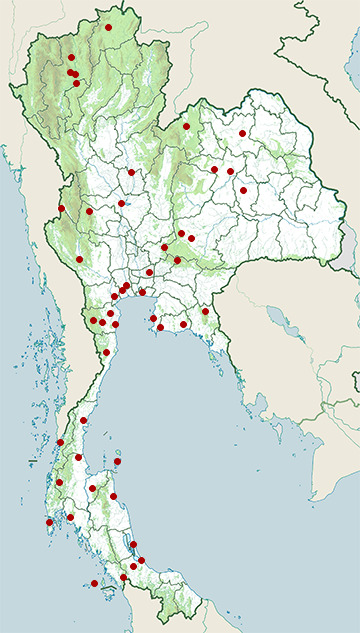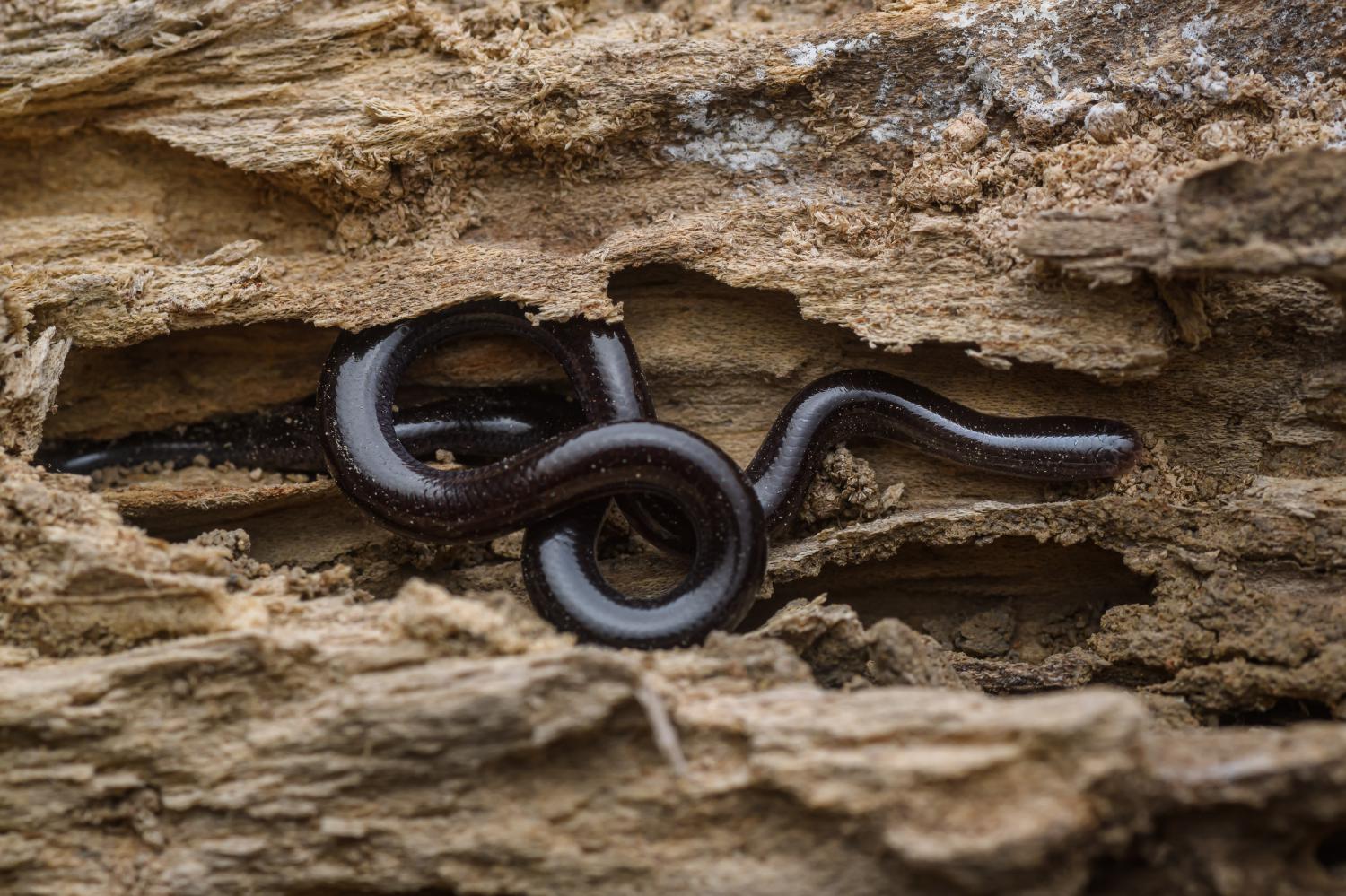Species of Thailand
Brahminy's blind snake
Indotyphlops braminus
(François Marie Daudin, 1803)
In Thai: งูดินบ้าน, ngu din baan
Indotyphlops braminus, commonly known as the brahminy blind snake and other names, is a non-venomous blind snake species found mostly in Africa and Asia, but has been introduced in many other parts of the world. They are completely fossorial (i.e., burrowing) reptiles, with habits and appearance similar to earthworms, for which they are often mistaken, although close examination reveals tiny scales and eyes rather than the annular segments characteristic of true earthworms. The species is parthenogenetic and all known specimens have been female. The specific name is a Latinized form of the word Brahmin. No subspecies are currently recognized.
Description
Adults measure 5.1–10.2 cm long, uncommonly to 15 cm, making it the smallest known snake species. The head and tail are superficially similar as the head and neck are indistinct. Unlike other snakes, the head scales resemble the body scales. The eyes are barely discernible as small dots under the head scales. The tip of the tail has a small, pointed spur. Along the body are fourteen rows of dorsal scales. Coloration ranges from charcoal gray, silver-gray, light yellow-beige, purplish, or infrequently albino, the ventral surface more pale. Coloration of the juvenile form is similar to that of the adult. Behavior ranges from lethargic in appropriate habitat to energetic, quickly seeking the cover of soil or leaf litter to avoid light.
The tiny eyes are covered with translucent scales, rendering these snakes almost entirely blind. The eyes cannot form images, but are still capable of registering light intensity.
Common names
I. braminus is variously known as the brahminy blind snake, flowerpot snake, common blind snake, island blind snake, teliya snake, and Hawaiian blind snake. The moniker "flowerpot snake" derives from the snake's incidental introduction to various parts of the world through the plant trade. "Kurudi" is the common Malayalam term which refers to braminus. "Sirupaambu" is the common Tamil term which refers to braminus.
Distribution
Most likely originally native to Africa and Asia, it is an introduced species in many parts of the world, including Australia, the Americas, and Oceania.
The vertical distribution is from sea level to 1, 200 m in Sri Lanka and up to 1, 500 m in Guatemala. The type locality given is "Vishakhapatam" .
Native range
In Africa, it has been reported in Uganda, DRC, Egypt, Kenya, Senegal, Benin, Togo, Nigeria, Ivory Coast, Cameroon, Zambia, Zimbabwe, Somalia, Zanzibar, Tanzania, Mozambique, South Africa (an isolated colony in Cape Town and Natal Midlands; about eight have been found in Lephalale, Limpopo Province at the Medupi Power Station during construction), Madagascar (Nossi Be), the Comoro Islands, Mauritius, the Mascarene Islands and the Seychelles. It has also been found in Libya.
In Asia, it occurs in the Arabian Peninsula, Lebanon, Iran, Philippines, Pakistan, Nepal, mainland India (as well as the Andaman Islands, the Nicobar Islands, and the Lakshadweep Islands, where it is the only snake reported), the Maldives, Sri Lanka, Bangladesh, Myanmar, Singapore, the Malay Peninsula, Thailand, Cambodia, Vietnam, Laos, southern China (including Hainan), Hong Kong, Taiwan, and Japan (in the Ryukyu Islands of Okinawashima and Miyakoshima).
In Maritime Southeast Asia, it occurs on Sumatra and nearby islands (the Riau Archipelago, Bangka, Belitung and Nias), Borneo, Sulawesi, the Philippines, Java, Bali, Flores, East Timor, Kai Island, the Aru Islands, New Guinea (Western Papua and Papua New Guinea), New Britain, and Bougainville Island.
It also occurs in the Cocos (Keeling) Islands, and on Christmas Island.
Introduced range
In Australia, it occurs in the Northern Territory near Darwin, and in parts of Queensland.
In Oceania, it occurs on Papua New Guinea, Palau, Guam, Fiji, Saipan, the Hawaiian Islands and Tahiti in French Polynesia.
In the Americas, it occurs in the United States (California, Connecticut, Florida, Georgia, Louisiana, Massachusetts, Arizona, Hawaii and Texas), western and southern Mexico, Guatemala, Belize, Colombia, Barbados and on the Cayman Islands, as well as the Turks and Caicos Islands. It has also been spotted in the Okanagan in B.C., Canada.
In Europe, it has been found in Spain (in the Canary Islands of Tenerife and Gran Canaria), in Italy (on the island of Ischia), and in Malta; it is believed to have been introduced in soil imported with potted plants, and has been labeled potentially invasive to native fauna.
Habitat
Usually, brahminy blind snakes occur in urban and agricultural areas. These snakes live underground in ant and termite nests. They are also found under logs, moist leaves, stones and humus in wet forest, dry jungle, abandoned buildings, and even city gardens. The distribution and survival of this group of blind snakes directly reflect soil humidity and temperature.
Feeding
Their diet consists of the larvae, eggs, and pupae of ants and termites.
Reproduction
I. braminus is parthenogenetic, and all specimens collected so far have been female. They lay eggs or may bear live young. Up to eight offspring are produced, all female and genetically identical. They are triploid, and it has been proposed that the species be transferred to a new genus as Virgotyphlops braminus because of its obligate parthenogenetic nature.
This article uses material from Wikipedia released under the Creative Commons Attribution-Share-Alike Licence 3.0. Eventual photos shown in this page may or may not be from Wikipedia, please see the license details for photos in photo by-lines.
Scientific classification
- Kingdom
- Animalia
- Phylum
- Chordata
- Subphylum
- Vertebrata
- Class
- Reptilia
- Order
- Squamata
- Suborder
- Serpentes
- Family
- Typhlopidae
- Genus
- Indotyphlops
- Species
- Indotyphlops braminus
Common names
- German: Brahmanen-Wurmschlange
- English:
- Brahminy blind snake
- Common blind snake
- Bootlace snake
- Flowerpot snake
- Thai: งูดินบ้าน, ngu din baan
Conservation status

Least Concern (IUCN 3.1)
Photos
Please help us review our species pages if wrong photos are used or any other details in the page is wrong. We can be reached via our contact us page.
Range Map

- Ban Chang District, Rayong
- Ban Lat District, Phetchaburi
- Ban Na San District, Surat Thani
- Ban Phaeo District, Samut Sakhon
- Bang Khonthi District, Samut Songkhram
- Bang Lamung District, Chonburi
- Borabue District, Maha Sarakham
- Cha-Am District, Phetchaburi
- Doi Suthep - Pui National Park
- Erawan National Park
- Hat Yai District, Songkhla
- Huai Kha Khaeng Wildlife Sanctuary
- Kaeng Krachan District, Phetchaburi
- Kaeng Krachan National Park
- Khao Soi Dao Wildlife Sanctuary
- Khao Sok National Park
- Khao Yai National Park
- Klaeng District, Rayong
- Ko Samui District, Surat Thani
- Kui Buri District, Prachuap Khiri Khan
- Mae Taeng District, Chiang Mai
- Muak Lek District, Saraburi
- Mueang Chiang Mai District, Chiang Mai
- Mueang Chiang Rai District, Chiang Rai
- Mueang Chumphon District, Chumphon
- Mueang Khon Kaen District, Khon Kaen
- Mueang Krabi District, Krabi
- Mueang Lamphun District, Lamphun
- Mueang Loei District, Loei
- Mueang Nakhon Sawan District, Nakhon Sawan
- Mueang Phichit District, Phichit
- Mueang Ranong District, Ranong
- Mueang Samut Prakan District, Samut Prakan
- Mueang Songkhla District, Songkhla
- Nong Han District, Udon Thani
- Nong Ruea District, Khon Kaen
- Sam Phran District, Nakhon Pathom
- Sathing Phra District, Songkhla
- Sikhio District, Nakhon Ratchasima
- Sung Noen District, Nakhon Ratchasima
- Tarutao National Marine Park
- Tha Chana District, Surat Thani
- Tha Sala District, Nakhon Si Thammarat
- Thalang District, Phuket
- Thale Ban National Park
- Thanyaburi District, Pathum Thani
- Thung Yai Naresuan Wildlife Sanctuary




